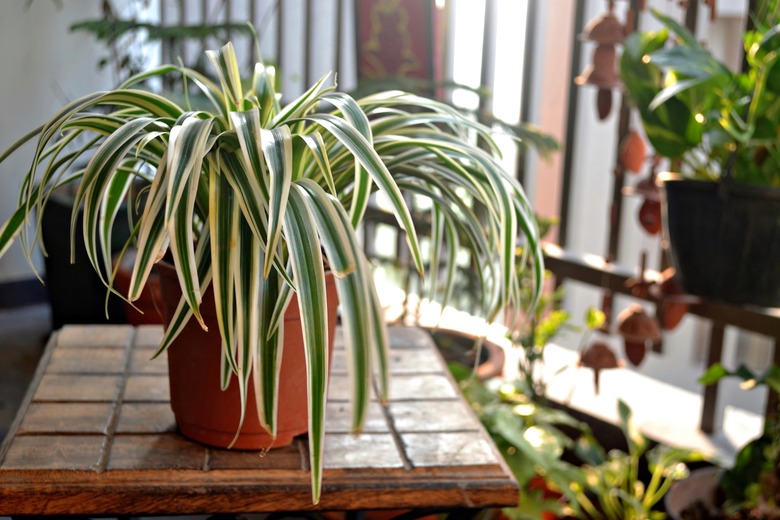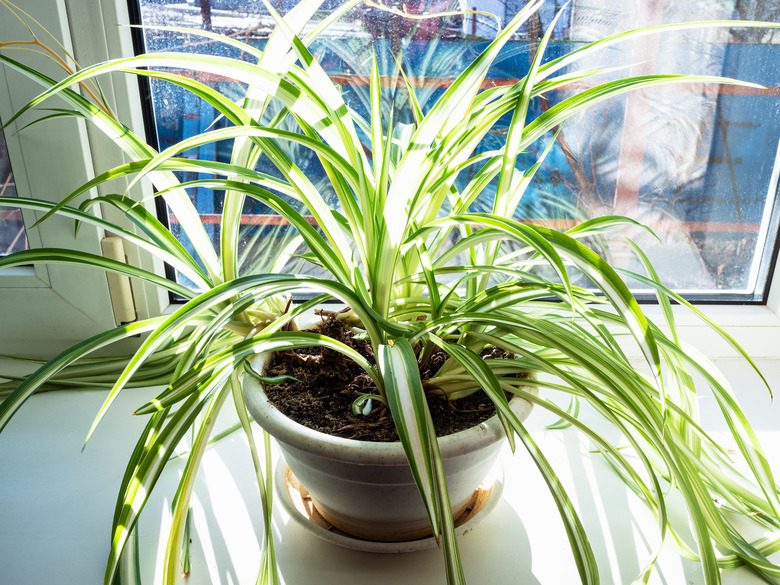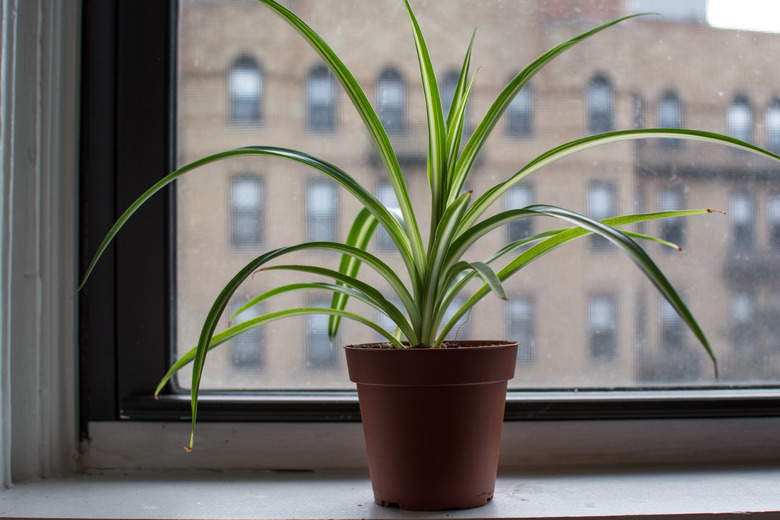How To Care For A Spider Plant
We may receive a commission on purchases made from links.
- Best uses for spider plants
- How to care for spider plants
- Soil, light, and water recommendations for spider plants
- Fertilizer recommendations for spider plants
- Humidity and temperature recommendations for spider plants
- How to prune spider plants
- Potting (and repotting) spider plants
- How to propagate spider plants
- Common pests and other problems for spider plants
- Common diseases for spider plants
When it comes to houseplants, the spider plant (Chlorophytum comosum, USDA zones 9-11) is a classic and with good reason. This easy-to-grow plant suits even the beginner (or that friend who forgets about her plants from time to time). Easily recognized with its grasslike, arching leaves, the spider plant often has variegated green leaves with stripes of yellow or white. These variegated or striped variations are even more common than spider plants with solid green leaves. Some spider plants even have curvy, twisted leaves, which look like curling ribbon that's been curled with scissors.
Best Uses for Spider Plants
Best Uses for Spider Plants
One great trait of the spider plant is its ability to remove some chemicals from indoor air. The spider plant is particularly good at removing benzene and other volatile organic chemical compounds (VOCs) that off-gas from common household materials, such as particleboard and plywood, some adhesives and coatings and even permanent-press fabric treatments. Although one plant in the house won't greatly impact indoor air quality, one air-purifying plant per 100 square feet, or about one per small room, makes at least a little difference.
Spider plants are also great for learning the ropes when it comes to plant care, as a little neglect generally won't harm them. This makes them a good choice for a home office or even an actual office. They're also a great choice for hanging baskets, as the foliage splays outward in an attractive display. Spider plants are one of the easiest houseplants to propagate, which makes them the quintessential gift that keeps on giving.
How to Care for Spider Plants
How to Care for Spider Plants
- Common Name: Spider plant
- Botanical Name: Chlorophytum comosum
- Sun Exposure: Moderate indirect sunlight
- Soil Type: Well-drained potting mix
- Mature Size: 15 to 24 inches
- When it's in Trouble: Tip burn, mealybugs or scale
- When it's Thriving: Abundant green or variegated green arching, grasslike foliage
Soil, Light and Water Recommendations for Spider Plants
Soil, Light and Water Recommendations for Spider Plants
Spider plants thrive in a general-purpose, organically rich potting medium. They enjoy medium to bright indirect light rather than direct sunlight, which may burn the leaves. They'll do just fine near an east-facing window or even a window facing south or west provided the plant receives shade for part of the day.
Water a young, unestablished spider plant when the soil seems completely dry. Once the plant is established, water weekly or when the top inch of soil feels dry. Water it enough so that the excess liquid soaks through; be sure the pot has sufficient drainage to avoid root rot. Feel free to cut back a little on watering during the winter. Hanging baskets are best watered over a sink, or they can even be taken outdoors at watering time to prevent water on the floor or nearby furniture.
Spider plants tend to be sensitive to chlorine and fluoride in some tap-water supplies. These chemicals could cause leaf tips to turn brown. Watering with rainwater or distilled water helps prevent the browning.
Fertilizer Recommendations for Spider Plants
Fertilizer Recommendations for Spider Plants
Fertilize spider plants once a month in summer at most using a water-soluble fertilizer or otherwise a few times a year using a slow-release houseplant fertilizer. Start by using half the recommended amount on the package. Avoid overfertilizing; besides the leaf tips browning, too much fertilizer could cause the plant to cut back on plantlet production.
Forgetting the fertilizer is better than using it too often; the plant may grow well with little to no fertilizer. The spider plant doesn't require fertilizer in fall and winter, which is true for many houseplants.
Humidity and Temperature Recommendations for Spider Plants
Humidity and Temperature Recommendations for Spider Plants
"Moderate" and "average" may be some of the best words used to describe nearly any aspect of spider plant care. It likes a moderate amount of humidity, essentially suited to the typical household most of the year. In situations where indoor air might be too dry, such as in the middle of winter, placing the plant in or near the bathroom gives it a little more humidity.
The spider plant prefers room temperatures between 65 and 75 degrees Fahrenheit, which makes it ideal in the typical home. These indoor plants tolerate temperatures from 55 to 80 degrees Fahrenheit but doesn't do well outside of that temperature range. On nice spring or summer days within its ideal temperature range, a spider plant also does well on a porch or patio in an area of indirect sunlight or at least partial shade. Keep it out of the bright direct sunlight, especially on a hot day.
How to Prune Spider Plants
How to Prune Spider Plants
A spider plant generally doesn't require pruning, but removing brown leaves and leaf tips helps keep the plant looking its best. Cut back brown tips using sanitized shears, cutting away most of the brown area but leaving part of it intact to avoid injury to the healthy part of the leaf. Instead of cutting straight across the leaf, trim it to resemble its original pointy shape, which makes the plant look more uniform and healthy after trimming.
If a leaf is dead or completely brown, simply tugging it may remove it from the plant. If not, cut it away near the place where it attaches to the main plant.
Potting (and Repotting) Spider Plants
Potting (and Repotting) Spider Plants
Spider plants actually enjoy being slightly root-bound and grow best in such conditions. The first pot you use for a young spider plant should be about a third larger than the plant's root ball since tight growing conditions are what it prefers. A pot just slightly larger than the one that came with your plant should do the job for a while.
It's time to repot a spider plant when the root ball becomes obvious above the pot rim or about once a year when the plant is young and every two years once it's mature. The spider plant can be repotted at any time of year indoors. Avoid fertilizing repotted plants for four to six months.
How to Propagate Spider Plants
How to Propagate Spider Plants
Spider plants are easy to propagate using the little plantlets, or spiderlike growths that show up on the end of long stems after the plant flowers. The plantlets are like miniature spider plants (sometimes called spiderettes), and they develop their own roots whether you place them in soil or not.
Propagation starts by setting the plantlet atop moist potting medium in a small pot while the plantlet is still attached to the main plant. This allows the mother plant to nourish the plantlet while it establishes its own roots in the soil. Keep the stem holding the plantlet in place atop the soil using a bent paperclip or floral wire bent over the edge of the small pot near the plantlet. Once the plantlet roots, cut it off the stem attached to the main plant.
You may also wait until the plantlet develops roots in midair; these look like little nubs on the bottom of the plantlet. In this case, trim the plantlet off the main stem and pot the plantlet roots in soilless potting medium, being careful not to press down the plant so much that you bury the crown. Water enough to keep the soil slightly moist whether using this method or if the plantlet is still attached to the main plant. Feel free to leave the long stem on the mother plant after removing a plantlet. In some cases, the plant develops more plantlets on the same stem.
Plantlets removed from the main plant may also be rooted in water. Simply set the new plant in a small jar or if the plant is small enough, even a shot glass containing just enough water to keep the root area, or the very bottom of the plantlet, under water. Once the roots establish themselves in water, transplant the new spider plant in a small pot.
Common Pests and Other Problems for Spider Plants
Common Pests and Other Problems for Spider Plants
Few insects bother the spider plant, but two that find the plant attractive are scale insects and mealybugs. Scale insects are hard and brown, while mealybugs have a cottony white appearance and may leave a similar cottony, sticky residue on the spider plant. Thankfully, both types of insects are easy to control; just rub the insects and the affected areas of the plant with a cotton swab dipped in rubbing alcohol. For best results, keep the affected plant away from other plants for a while to avoid contaminating the others.
Overwatering and underwatering can also cause issues for a spider plant and many other houseplants for that matter. Overwatering to the point that the plant pot can't drain well could cause root rot, which may kill the plant. An incorrect potting mix, such as one that holds too much water, could contribute to this issue. In some cases, the plant's roots might block the drainage holes, so with a mature plant, it's important to check the bottom of the pot from time to time to ensure the water still drains.
Underwatering could make the plant wilt, or it may cause the leaf tips to turn brown — though these conditions can be temporary if you remedy your watering routine. Too much fertilizer could also cause tip burn, so if you aren't sure about what's going on, consider whether you've watered the plant enough recently or whether you've applied too much fertilizer.
Common Diseases for Spider Plants
Common Diseases for Spider Plants
The spider plant typically has no disease-related issues. This could be one of the reasons it's one of the most common easy-care houseplants available.
References
- The Old Farmer's Almanac: Growing Spider Plants
- Wisconsin Horticulture Division of Extension: Spider Plant, Chlorophytum comosum
- ProFlowers: Spider Plant Care Guide: Growing Information + Tips
- United States Environmental Protection Agency: What Should I Know About Formaldehyde and Indoor Air Quality?
- The Old Farmer's Almanac: Clean House With Tropical Plants
- American Society for the Prevention of Cruelty to Animals: Spider Plant
- University of Florida IFAS Gardening Solutions: Spider Plant
- University of Vermont Department of Plant and Soil Science: Easy Houseplants – Spider Plant


